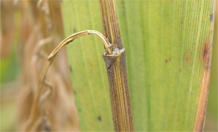
Rice blast is the most serious disease of cultivated rice
University of Exeter research uncovers rice blast infection mechanism
Scientists at the University of Exeter have made a new discovery that they hope might lead to effective control of rice blast disease.
Rice blast is the most serious disease of cultivated rice and affects all the rice-growing regions of the world, causing losses of up to 30% of the global rice harvest.
Yasin Dagdas and colleagues studied the rice blast fungus, which develops a pressurised infection cell, called an appressorium to rupture the rice leaf cuticle. The appressorium generates extreme pressure, estimated to be 40 times that of a car tyre. Dagdas and colleagues, who work under the supervision of Prof. Nick Talbot, have identified how the fungus channels its pressure to form a narrow infection peg that breaches the rice leaf surface. Their work implicates a specialised group of proteins called septins in plant infection for the first time. These proteins may be important to allow the rigid, pressurised cell to focus force at the point of plant infection.
Yasin Dagdas said: “This is another step in our journey to discover how this devastating fungus works and we hope, in the future, may help prevent the destruction of so much of the world’s rice production”.
Published today (21 June 2012) in the journal Science, the team came to its conclusion by analysing the septin gene family and its role in re-organisation of the infection cell, so that it grows an infection peg that extends through the rice cuticle and into rice tissue. The project used live-cell imaging, molecular genetics and genomic procedures and represents a significant breakthrough in our understanding of the plant infection process by cereal-infecting fungi. This could ultimately impact upon control of a range of rice, wheat and barley diseases.
Speaking about the discovery, Prof. Nick Talbot said “Rice blast is a terrible disease, affecting some of the poorest regions of the world. We hope that this discovery will allow us to understand plant infection in more detail and we can then apply the knowledge to provide better solutions to farmers in controlling blast outbreaks”.
Date: 22 June 2012
